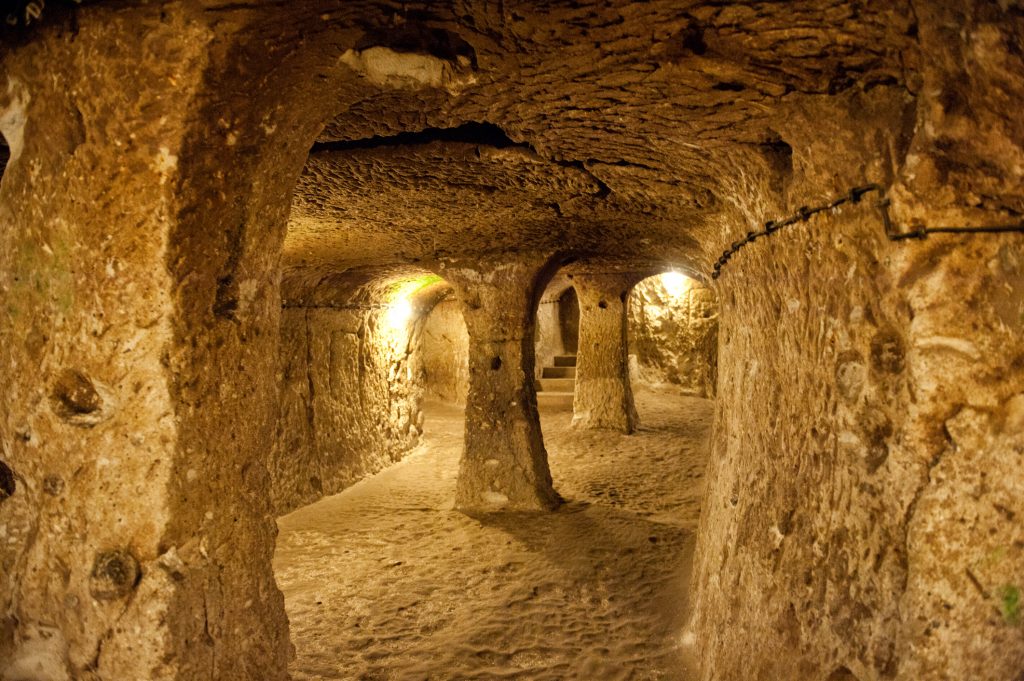It was just a regular day for Mustafa Bozdemir in 1963 as he made renovations to his home in Nevşehir Province, Turkey. That is until Mustafa knocked down a wall of his home and behind it, discovered a whole new room. Connected to this room was an entire city built for nearly twenty-thousand people.1 This city is what became know as Derinkuyu, one of the ancient world’s biggest mysterious.

What we know about who built and lived in the city of Derinkuyu still remains unknown. According to one theory, the city’s beginning dates to 800 B.C.E. when Derinkuyu was built and inhabited first by the Hittites from the Old Kingdom period for an estimated short one-hundred years.2 After the fall of the Hittites around 700 BCE, historians have come to the conclusion that the Phrygians inhabited Derinkuyu.3 Derinkuyu was a sanctuary for the people who lived above ground in the Cappadocia region of modern-day Turkey. The entire region of Cappadocia above Derinkuyu was under constant attack. Since they were under constant attack, this inspired another theory that the majority of the twenty-thousand people who lived within Derinkuyu were refugees from the war between the Arab tribes and Byzantine Christians who were at war overhead around 650 BCE.4

Derinkuyu was equipped with amenities, created with technology far beyond their time. Such amenities included housing for livestock, ventilation chimneys, churches, and schools.5 Archaeologists were baffled by the design of Derinkuyu. The engineering used to build Derinkuyu was with a technology that seems to be from a later time. The cities were carved out of volcanic rock found underground. Since protection was their number one priority, multiple mechanizations were put in place in order to ensure their protection.6 Such mechanization included rolling stone doors to close off various tunnels. In the case of an attack, the rolling stone doors would block any entrances to trap intruders within the tunnel. In the roof of the tunnels, what would appear to be ventilation holes, were actually holes to pour oil on any intruders.7
Derinkuyu was a thriving city for an estimated four-hundred years. Another question historians have about Derinkuyu is what happened to its people? Once Derinkuyu was discovered, it did not take researchers long to learn that it was connected to multiple other underground cities in the surrounding area, including Goreme and Kaymakli.8 Historians have come to the conclusion that Derinkuyu must have been under attack, and people fled to one of the surrounding cities; however, it is still uncertain.

The majority of Derinkuyu’s history may never be known; however, this mysterious city is still an important part of ancient Turkey. Derinkuyu has influenced engineers today to consider the possibility of building underground cities as the population and need for living space continues to grow. Today Derinkuyu has become a tourist attraction for people all over the world.9
- Vladimír Nývlta, Josef Musíleka , JiĜí ýejkab , Ondrej Stopkac, “The Study of Derinkuyu Underground City in Cappadocia Located in Pyroclastic Rock Materials,” Procedia Engineering 161 ( 2016 ): 2253. ↵
- Fitzroy Dearborn, The Hutchinson Dictionary of Ancient and Medieval Warfare (London, UK : Reaktion Books, 2016), 146. ↵
- Benedict Anderson, Buried City, Unearthing Teufelsberg: Berlin and Its Geography of Forgetting ( New York : Routledge, 2017), 13. ↵
- Dig into history, February 2016, s.v. “‘Uncovering’ an underground city,” by Catie Steidl. ↵
- Dobraszczyk, Paul, Galviz, Carlos López, Garrett, Bradley L, Global Undergrounds: Exploring Cities Within (London, UK : Reaktion Books, 2016), 35. ↵
- C. J. Lim, Inhabitable Infrastructures: Science Fiction or Urban Future? (New York, NY: Routledge, 2017), 279. ↵
- Tony Wright, Turn Right at Istanbul: A Walk on the Gallipoli Peninsula (Crows Nest, N.S.W. : Allen & Unwin, 2003), 67. ↵
- Henry Herman, Dominance and Aggression in Humans and Other Animals: The Great Game of Life (London, United Kingdom: Academic Press, 2017), 297. ↵
- Lynn Levine, Frommer’s Turkey: From the Blue Mosque to the Blue Lagoon (3rd ed. Hoboken, NJ : John Wiley & Sons, Inc, 2004), 344. ↵



71 comments
Esperanza Rojas
This story went from left to right in a good way. First off, I couldn’t even imagine of I had found an underground city when all I wanted to do was rebuild my home. This city certainly left its mark, and I wonder why we don’t learn much about it in school, especially if it is described as one of the cities that was “beyond their time”. I find it fascinating and now wish to know more as to why and how it was far beyond it’s time, as well as learn why they used oil as a defense strategy.
Kristy Feather
This story on Derinkuyu is fascinating. It reminds me a lot of the Roanoke colony and it forces us to think about how easily an entire civilization can just disappear. For all we know our own civilizations can die off soon, only to be left buried beneath other peoples who will stumble upon us totally by accident in the future. It’s amazing to think that there are so many civilizations out there that might be just below the surface (both literally and metaphorically), ones that have disappeared without a trace or even ones that we just don’t know about yet.
Alexander Manibusan
The thick cloud of mystery that covers Derinkuyu really interests me. My question is how do historians know (or likely suspect) that the Hittites first inhabited Derinkuyu? Also is it possible that the Hittites established the settlement but then the Phrygians gradually improved the city? My other question is the time. It is said that the 20,000 residents of Derinkuyu were refugees from the wars “between the Arab tribes and Byzantine Christians… around 650 BCE.4” I’m a bit confused since I assume that Christianity started much later than 650 BCE. Nonetheless, this was a very captivating read!
Belia Camarena
I found story of the lost city of Derinkuyu really fascinating! It is astounding to read that a city this big was built underground and then inhabited by so many people. We may never know who built the city or the exact reason they did, but it is clear that these people were very technologically advanced, since they had inventions at the time that the rest of the world had not seen yet.
Caroline Bush
Great article! I had never heard about Derinkuyu until reading this article. I find it amazing how a group of people were able to form such a mysterious and complex living environment. The fact that this city can be dated back to 800 B.C.E and it still being intact today is really interesting. I also really enjoyed the amount of details and pictures included in this article Overall I really enjoyed reading this article and found the topic to be fascinating.
Iris Henderson
The story of this ancient underground city, Derinkuyu, in modern day Turkey was an excellent read. This is a story that I have never even vaguely heard about. It was interesting to learn about how advanced these ancient people’s minds must have been to develop a complete underground society. In addition to their own housing they had a complete society underground consisting of housing for livestock, churches, schools, chiminey ventilation systems, and protections in place in case of attacks. This location has definitely been added to my bucket list!
Evian-loren Salgado
This was a very interesting and intriguing article. It was well written and very informative. I loved that the writer included many details about the city and as much history that was known about the mysterious city. It was also very interesting to read how the underground city had the capability to defend itself from invaders. For example the rolling stone door or the hole the people would use to pour oil on anyone who invaded. This was very interesting to read.
Samuel Ruiz
Great article! I have always wandered what it would be like to live underground but to learn that a city actually functioned underground is very mind blowing. It is unfortunate that only theories exist regarding the purpose for and use of the city underground but it is till nice to know that the city exists and is available for tourist visits.
Destiny Flores
I found this article really interesting. It’s crazy to think, way back then, that they were capable of the thought process that was required to build something, such as these tunnels, with sturdy enough architecture to last for years. Having traveled to Turkey, I’ve come to appreciate the culture and love learning all that I can about it and find these tunnels really captivating.
Megan Barnett
I had never heard of a city built underground like this one. I found that the way the people structured Derinkuyu as a way to defend themselves was very clever, and if the city can be dated back to 800 B.C.E, while still being a tourist attraction today, then I would assume that it stayed in decent shape which is pretty remarkable.